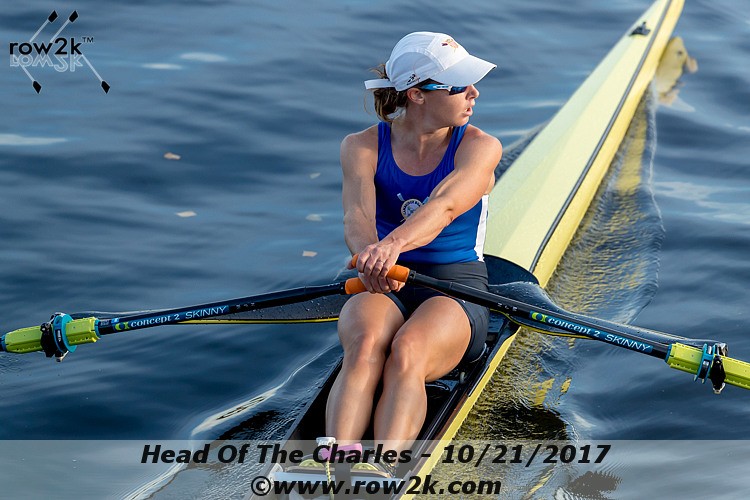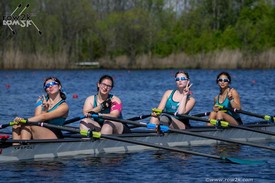Charlotte Hollings, Calm Waters Rowing

After what seemed like a never-ending winter, spring seems to have arrived on the east coast. Before you get too many miles in under your belt, make sure you're getting in good technique and ingraining good habits. Water temps are still low enough that probably few of you are getting out in your singles. Take advantage of this opportunity - however forced - to go out in big boats and work on skills and drills that you might not feel comfortable doing in a small boat, especially this time of year.
One habit I try to instill in every single sculler is to get comfortable sitting at the catch with the blades squared and buried. Once you're able to do this, make it your automatic starting point whenever you start from a dead start. Many scullers are not comfortable doing this in their single, so practice it in a double or quad.
There are so many reasons I advocate this habit, starting with getting the correct grip. As you're sitting with the blades squared, make sure your wrists are flat, that only your fingers have contact with the oar and not with the palm of your hand, as in the photo at the top of this article.
With the correct grip, it's harder to over grip which is particularly easy to do when the water is cold and the wind picks up and you start to feel a little tippy. Use the relative stability of a bigger boat to consciously relax your grip and really hang from the fingers rather than clutching the oar handle. The correct grip will help you to connect to the lat muscles whereas, when you over grip, tension ends up in the shoulders and traps.
Another benefit to starting from the catch is that you can check the depth of the blades and the relative height of the hands. The blades should sit just below the surface of the water then stay at that depth throughout the drive. You need to know just what height the hands should be to keep the blade at the right level. If the arms are stiff and elbows locked, the connection will be to your shoulders, a point much higher than your hands, helping to drive the oar deep. With relaxed elbows, the elbows stay at the height of your hands and you'll be better able to pull horizontally, keeping the blade at the correct depth.

If you're having trouble with blade depth, have some fun in the big boats by rowing one at a time in the 2x or 4x and letting the oars float through the drive. Lift your fingers off the oar and simply hover your hands just above the oar handle. Look out of the boat and see just where the blades float ON THEIR OWN. They want to be at this depth, you need to relax and allow this to happen, don't fight the oars.
When starting from the catch position, you're starting the stroke cycle at the beginning of the drive; the catch is already completed. See how smooth you can make that initial drive - don't kick or slam the legs down. With the blades already in the water, you should feel an immediate connection when you drive. Can you make the next stroke feel the same way? Think catch first, then drive.
One drill to work on this is the finish-to-catch drill, another tricky drill in the single, so again, try it in the bigger boats with one or two people setting the boat. Sit at the finish and then in one fluid motion move to the catch. Our mantra is "body-slide-catch", not "arms-body-slide". Move directly to the water, making the catch the last part of the recovery not the first part of the drive.

The idea then is to essentially make every stroke a finish to catch drill. This should lighten your catches, helping to keep the blades from going deep and, in the process, reduce check.
Hopefully the water will warm up quickly and we'll be back in our singles, rowing better and cleaner than ever. Until then, be safe and take advantage of those big boats.
(This article is addressed primarily towards scullers. If you are a sweep rower, everything still applies but think pair for single and 4 or 8 for 2x and 4x.)
If you enjoy and rely on row2k, we need your help to be able to keep doing all this. Though row2k sometimes looks like a big, outside-funded operation, it mainly runs on enthusiasm and grit. Help us keep it coming, thank you! Learn more.
Comments | Log in to comment |
- Bont Rowing
- Calm Waters Rowing
- Concept 2
- Craftsbury Sculling
- The Crew Classic
- CrewLAB
- Croker
- Dad Vail Regatta
- Durham Boat Co.
- Empacher
- Faster Masters
- Filippi
- Fluidesign
- h2row.net
- HUDSON
- Live2Row Studios
- Nielsen-Kellerman
- Oak Ridge RA
- Peinert Boat Works
- Pocock Racing Shells
- Race1 USA
- Rockland Rowing Masters Regatta
- RowKraft
- Rubini Jewelers
- Vespoli USA
- WinTech Racing
- Bont Rowing
- Calm Waters Rowing
- Concept 2
- Craftsbury Sculling
- The Crew Classic
- CrewLAB
- Croker
- Dad Vail Regatta
- Durham Boat Co.
- Empacher
- Faster Masters
- Filippi
- Fluidesign
- h2row.net
- HUDSON
- Live2Row Studios
- Nielsen-Kellerman
- Oak Ridge RA
- Peinert Boat Works
- Pocock Racing Shells
- Race1 USA
- Rockland Rowing Masters Regatta
- RowKraft
- Rubini Jewelers
- Vespoli USA
- WinTech Racing


















04/12/2018 2:16:48 PM
04/19/2018 3:36:21 PM